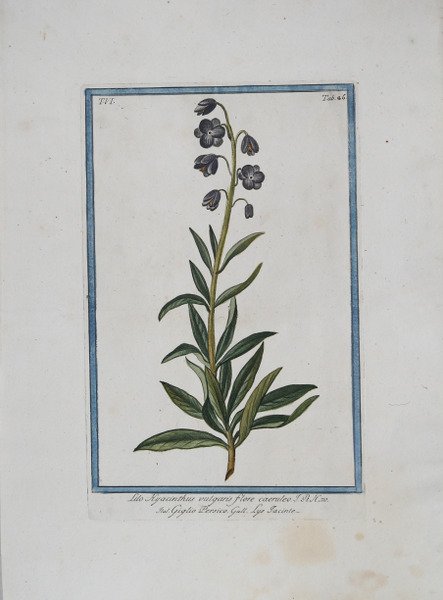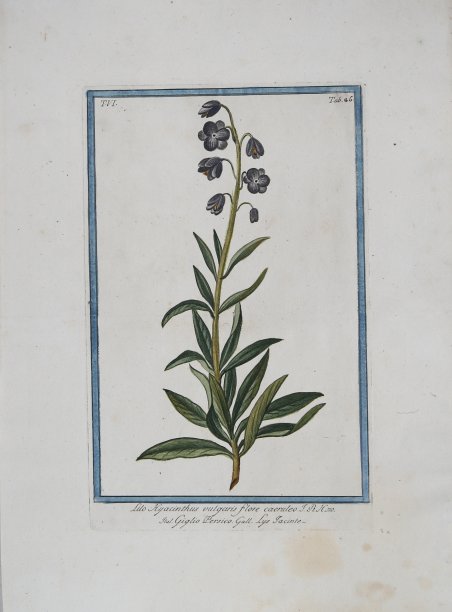Tavola botanica tratta dal monumentale Hortus Romanus Juxta Systema Tournefortianum Paulo Strictius Distributus A Georgio Bonelli Monregalensi In Subalpinis, Publico Medicinae Professore: Specierum Nomina Suppeditante, Praestantiorum, Quas Ipse Selegit, Adumbrationem Dirigente Liberato Sabbati Maevaniensi In Umbria Chirurgicae Professore, Et Horti Custode; Adjectis Unicuique Volumini Rariorum Plantarum Tabulis C. Aere Incisis. Tom. I. (- Tom. VII.) L’opera viene stampata a Roma durante l’arco di ben 22 anni e da diversi editori: a spese di Bouchard e Gravier: Paolo Giunchi, 1772-1780-Tipografia Salomoni, 1784-Giovanni Zempel, 1793. Prima edizione di questa monumentale opera di botanica, sicuramente la più vasta e riccamente illustrata tra quelle prodotte in Italia fino ad allora. Intorno al 1770 gli editori francesi Bouchard e Gravier, avendo intenzione di dare alle stampe un catalogo illustrato dell’Orto botanico di Roma, ne proposero la direzione al medico piemontese Giorgio Bonelli (1724-1782), allora docente presso l’università romana. La cura della preparazione dei campioni per l’apparato iconografico fu invece affidata a Liberato Sabbati (1714-1778), un farmacista umbro, che era allora custode dell’Orto medesimo. Il primo volume uscì nel 1772 con una ricca introduzione del Bonelli, in cui questi fornisce un resoconto dei più recenti sviluppi della botanica e dei nuovi sistemi di classificazione e adduce poi i motivi della sua preferenza per il sistema elaborato da Joseph Pitton de Tournefort, a suo avviso più semplice e adatto all’apprendimento. Per ragioni ignote Bonelli abbandonò tuttavia l’impresa. Nel 1774, a partire dal secondo volume, essa fu presa in mano e poi condotta a termine da Niccolò Martelli (1735-1829), docente di botanica della Sapienza. Questi dette all’opera un’impostazione più linneana, pur continuando ad avvalersi della collaborazione di Liberato Sabbati fino alla sua morte, che avvenne nel 1778 al termine della pubblicazione dei primi cinque volumi. Il suo posto fu quindi preso dal figlio Costantino Sabbati. L’Hortus romanus contiene la classificazione delle varie specie di piante ospitate nell’Orto Botanico di Roma, che, stando a quanto affermato nella Horti Romani brevis historia che apre il primo volume, fu fondato a metà del Quattrocento sotto il pontificato di Niccolò V. In realtà i primi orti botanici italiani furono quelli creati a Padova e a Pisa intorno al 1545. L’Orto Romano sorse poco tempo dopo e, ampliatosi più volte, nel 1660 fu trasferito dalla sede vaticana al Gianicolo, dove ancora oggi si trova. La maggior parte delle tavole numerate non sono firmate, ma alcune sono firmate come incise da Magdalena Bouchard Il primo volume è dedicato dagli editori, Joannes Bouchard et Joannes Josephus Gravier, al Papa Clemente XIV; il secondo, al Cardinale Bernis; il terzo, al Cardinale Zelada; il quarto, al Cardinale Giraud. Il sesto volume è dedicato - dall'autore, Nicolaus Martelli - al cardinale Boncompagni. Acquaforte, finemente colorata a mano in epoca, in perfetto stato di conservazione. Bibliografia K. Nissen, ' Die botanische Buchillustration, 2 v. & suppl. (1951-1966); Great Flower Books p. 51. Hunt 629. Cleveland Botanical 509. Dunthorne 45. Pritzel 976. Nissen, BBI 200. Stafleu & Cowan TL2 634. Botanical plate from the Hortus Romanus Juxta Systema Tournefortianum Paulo Strictius Distributus A Georgio Bonelli Monregalensi In Subalpinis, Publico Medicinae Professore: Specierum Nomina Suppeditante, Praestantiorum, Quas Ipse Selegit, Adumbrationem Dirigente Liberato Sabbati Maevaniensi In Umbria Chirurgicae Professore, Et Horti Custode; Adjectis Unicuique Volumini Rariorum Plantarum Tabulis C. Aere Incisis. Tom. I. (- Tom. VII.) The work was printed in Rome over a period of 22 years and by different publishers: at the expense of Bouchard and Gravier: Paolo Giunchi, 1772-1780-Tipografia Salomoni, 1784-Giovanni Zempel, 1793. First edition of this monumental work of botany, certainly the most extensive and richly illustrated among those produced in Italy until then. Around 1770, the French editors Bouchard and Gravier, having the intention of printing an illustrated catalog of the Botanical Garden of Rome, proposed the direction to the Piedmontese doctor Giorgio Bonelli (1724-1782), then a professor at the University of Rome. The care of the preparation of samples for the iconographic apparatus was instead entrusted to Liberato Sabbati (1714-1778), an Umbrian pharmacist, who was then custodian of the Garden itself. The first volume was published in 1772 with a rich introduction by Bonelli, in which he gives an account of the most recent developments in botany and new systems of classification and then gives the reasons for his preference for the system developed by Joseph Pitton de Tournefort, in his opinion simpler and more suitable for learning. For unknown reasons Bonelli abandoned the enterprise. In 1774, starting with the second volume, it was taken over and then completed by Niccolò Martelli (1735-1829), professor of botany at the Sapienza. Martelli gave the work a more Linnean approach, while continuing to use the collaboration of Liberato Sabbati until his death in 1778 at the end of the publication of the first five volumes. His place was taken by his son Costantino Sabbati. The Hortus romanus contains the classification of the various species of plants housed in the Botanical Garden of Rome, which, according to what is stated in the Horti Romani brevis historia that opens the first volume, was founded in the mid-fifteenth century under the pontificate of Nicholas V. In reality, the first Italian botanical gardens were created in Padua and Pisa around 1545. The Roman Garden arose shortly thereafter and, expanded several times, in 1660 was transferred from the Vatican to the Janiculum, where it is still located today. Most of the numbered plates are unsigned, but a few are signed as engraved by Magdalena Bouchard The first volume is dedicated by the publishers, Joannes Bouchard et Joannes Josephus Gravier, to Pope Clement XIV; the second, to Cardinal Bernis; the third, to Cardinal Zelada; the fourth, to Cardinal Giraud. The sixth volume is dedicated - by the author, Nicolaus Martelli - to Cardinal Boncompagni. Etching, with fine contemporay colouring, good condition. References K. Nissen, ' Die botanische Buchillustration, 2 v. & suppl. (1951-1966); Great Flower Books p. 51. Hunt 629. Cleveland Botanical 509. Dunthorne 45. Pritzel 976. Nissen, BBI 200. Stafleu & Cowan TL2 634. Cfr.


Découvrez comment utiliser
Découvrez comment utiliser

